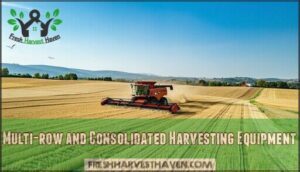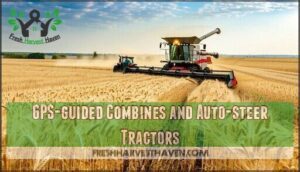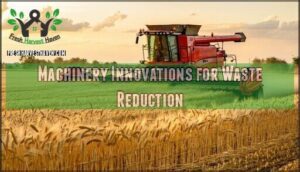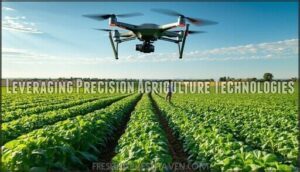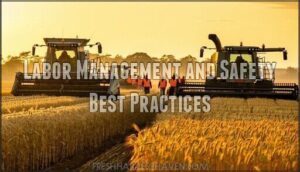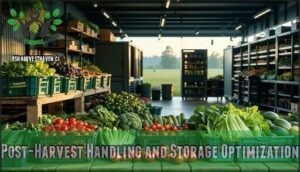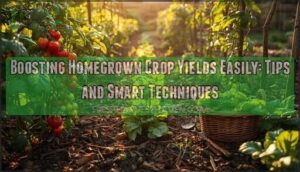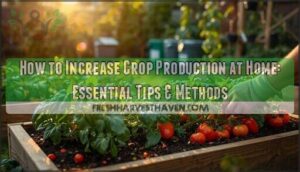This site is supported by our readers. We may earn a commission, at no cost to you, if you purchase through links.
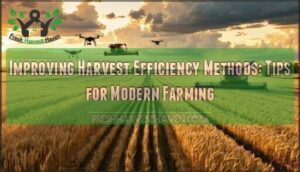
Precision agriculture technologies now enable real-time adjustments that align harvest timing with peak crop maturity, while strategic crop rotation reduces labor bottlenecks by up to 25%. The integration of GPS-guided equipment, multi-row harvesters, and data-driven soil management creates a compounding effect: each optimization amplifies the others.
Your harvest efficiency directly determines not just this season’s returns, but your competitive positioning for years ahead.
Table Of Contents
- Key Takeaways
- Key Factors Influencing Harvest Efficiency
- Advanced Machinery and Harvesting Techniques
- Leveraging Precision Agriculture Technologies
- Labor Management and Safety Best Practices
- Post-Harvest Handling and Storage Optimization
- Frequently Asked Questions (FAQs)
- How do weather fluctuations affect harvest scheduling decisions?
- What maintenance schedules maximize equipment uptime during harvest?
- How can small farms afford precision agriculture investments?
- What are effective pest management strategies during harvest?
- How do you balance speed and quality when harvesting?
- Conclusion
Key Takeaways
- Strategic crop rotation delivers 10–25% workload reductions and up to 8% efficiency gains by spreading harvest timing across different crops, cutting peak labor demands while improving equipment utilization by 18% and reducing overtime costs by 7–25%.
- Precision agriculture technologies—including GPS-guided combines, yield monitors, and real-time data tracking—transform harvest decisions from reactive guesswork into proactive strategy by capturing field-level variations and enabling immediate operational adjustments that minimize waste and maximize quality.
- Multi-row harvesters and consolidated equipment designs cut harvest time in half by integrating cutting, sorting, and crop management into single-pass systems, eliminating redundant field passes while reducing operator fatigue and overlap waste through sub-inch GPS accuracy.
- Post-harvest handling protocols—particularly rapid cooling systems maintaining 32-40°F with 90-95% humidity and temperature-controlled transport—can reduce spoilage losses by up to 50%, directly protecting profit margins that field efficiency alone cannot secure.
Key Factors Influencing Harvest Efficiency
Harvest efficiency doesn’t happen by accident—it’s shaped by the decisions you make before a single crop is pulled from the ground. Timing, soil condition, rotation strategy, and crop-specific planning all determine whether you’re maximizing yield or leaving value in the field.
Here’s what you need to get right.
Optimal Harvest Timing and Scheduling
You’ll often find that the difference between a bumper crop and a disappointing yield comes down to timing—harvesting too early or too late can cost you both quality and profit. Strategic seasonal planning using scheduling tools and crop yield forecasts lets you pinpoint your ideal harvest window with precision.
Consider these timing strategies for harvest optimization:
- Monitor real-time weather patterns to adjust your harvest season schedule
- Use precision agriculture data to track crop maturity indicators
- Leverage digital forecasting to predict peak harvest efficiency windows
- Align equipment availability with projected crop yield peaks
Impact of Crop Rotation on Workload
Strategic crop rotation transforms your workload from chaotic scramble to controlled rhythm. By staggering harvest dates across different crops, you’ll cut peak labor demand by 10–25% while boosting annual harvest efficiency by up to 8%. Consider how rotating corn, soybeans, and wheat spreads equipment use and reduces machinery idle time by 18%—your combines work smarter, not harder. The data speaks volumes:
| Rotation Strategy | Workload Impact | Efficiency Gain |
|---|---|---|
| Corn-Soybean Sequence | 8% harvest efficiency boost | Reduced bottlenecks through staggered timing |
| Peanut-Sweet Potato with Cereals | 13–60% labor productivity increase | Optimized labor allocation across cycles |
| Non-cereal before Cereals | 26–32% productivity jump | Enhanced harvesting labor peaks management |
| Legume Integration | 12–22% workload reduction | Fewer fertilizer applications needed |
| Multi-crop Rotations (2+ per year) | 17% scheduling flexibility improvement | Better equipment deployment windows |
Effective crop rotation planning involves analyzing soil health metrics to fine-tune crop selection and rotation strategies.
This approach to seasonal labor planning and workload distribution methods delivers consistent 38–54 hour work weeks instead of unpredictable spikes. Your labor allocation strategies become predictable, cutting overtime costs 7–25% while improving worker satisfaction by 14%. Harvest scheduling tools paired with rotation patterns reduce injury rates by 11% and sick days by 17%—healthier crews mean sustained agricultural productivity.
Plus, crop yield management stabilizes as diversified rotations maintain steady outputs, eliminating the yield swings that plague single-crop systems. The soil health benefits create compounding returns: 15–30% fewer pesticide applications mean fewer labor hours on chemical treatments, while improved farm equipment utilization keeps your machinery running efficiently across extended harvest windows.
Importance of Soil Health and Fertility
While rotation patterns dictate when you harvest, the soil beneath your crops determines whether those harvest windows deliver premium yields or disappointing returns. Soil health management anchored in organic matter drives crop yield optimization—every 1% increase in organic content boosts water retention 20% and feeds soil microbes that release nutrients.
Your fertility management program must balance soil amendment timing with crop nutrition demands, while erosion control protects topsoil that takes decades to rebuild. Strategic fertilizer programs calibrated to soil tests transform mediocre harvests into record-breaking returns.
Strategic Planning Based on Crop Type
Each crop type brings its own harvest calendar, equipment demands, and profit margins—so your planning framework can’t rely on one-size-fits-all formulas. Crop yield analysis paired with soil mapping reveals which varieties optimize farm productivity optimization in specific zones.
Harvest scheduling synchronized with crop selection and precision agriculture data transforms crop management into a competitive advantage.
Crop rotation patterns that align farm layout with equipment logistics don’t just boost harvest efficiency—they compound returns season after season.
Advanced Machinery and Harvesting Techniques
Modern harvesting isn’t just about manpower anymore—it’s about precision, speed, and making every pass count. The right machinery can transform your operation from labor-intensive to efficient, cutting costs while boosting yields.
Here’s what you need to know about the equipment and techniques that are redefining efficiency on today’s farms.
Multi-row and Consolidated Harvesting Equipment
When you’re racing against weather windows and market demands, multi-row harvesters become your secret weapon for slicing harvest time in half while keeping quality intact.
These consolidated harvest equipment designs merge cutting, sorting, and crop management into optimized farm automation systems, eliminating redundant passes across your fields.
By improving harvest efficiency through integrated machinery design, you’ll minimize equipment maintenance cycles while maximizing harvest speed—delivering the agricultural efficiency and precision agriculture approach that modern farm equipment demands.
GPS-guided Combines and Auto-steer Tractors
Precision steering transforms your combine into a tireless navigator that holds sub-inch accuracy across every pass, eliminating overlap waste and operator fatigue before they erode your profit margins.
Auto steer and GPS navigation deliver precision farming advantages through:
- Autonomous tractors that reduce operator stress during 12-hour shifts
- GPS-guided combines that eliminate costly double-coverage in low-visibility conditions
- Farm automation systems enabling night operations when crop moisture is ideal
- Agricultural technology and innovation driving farm efficiency strategies that boost profitability
Yield Monitors and Real-time Data Tracking
Your combine’s digital dashboard isn’t just flashing numbers—it’s painting a real-time portrait of every bushel crossing your header, revealing the hidden patterns that separate break-even seasons from banner years.
Yield Monitors equipped with Real-Time Monitoring capabilities transform Crop Yield Analysis from retrospective guesswork into immediate intelligence. Data Tracking Tools feed Farm Management Software that maps yield variations down to grid-level precision, enabling Harvest Optimization decisions while you’re still in the cab. Precision Agriculture demands Precision Farming Tools that capture Crop Yield fluctuations, turning raw data into Harvest Efficiency insights.
| Metric Tracked | Optimization Impact |
|---|---|
| Moisture content | Adjust harvest speed to maintain quality standards |
| Yield per acre | Identify underperforming zones requiring soil intervention |
| Grain loss | Recalibrate combine settings to reduce waste |
| Operational speed | Balance throughput with crop damage thresholds |
| Header efficiency | Detect blockages before they cascade into downtime |
Machinery Innovations for Waste Reduction
Modern Harvest Automation and Sustainable Equipment designs cut losses before they cascade into revenue leaks. Machinery Design innovations in GPS-guided Combines and Farm Equipment refine Harvest Efficiency by minimizing mechanical damage, reducing fuel consumption, and lowering environmental footprints through Ecofriendly Farming practices. Agricultural Technology advances paired with Precision Agriculture Techniques deliver Waste Reduction across every operational phase:
- Variable-rate header controls adjust cutting height to prevent grain shattering and soil contamination
- Adaptive threshing systems self-calibrate based on moisture levels, reducing kernel damage by up to 30%
- Residue management attachments distribute chaff evenly, improving decomposition rates and soil organic matter
- Fuel-efficient engines with regenerative braking capture energy during deceleration, lowering operational costs
- Modular design platforms allow quick component swaps, extending equipment lifespan and reducing replacement waste
The integration of Sustainable Practices such as digital sensor systems bolsters farm management and reduces environmental impact.
Leveraging Precision Agriculture Technologies
Precision agriculture transforms raw field data into strategic harvesting decisions that optimize yield while minimizing waste. You’ll need the right technology stack to capture, analyze, and act on real-time insights from your operation.
Here’s how modern digital tools boost your harvest efficiency beyond traditional methods.
GIS and Remote Sensing for Field Monitoring
Geographic Information Systems and remote sensing technologies act as your farm’s all-seeing eye, capturing crop variations across every acre with satellite precision that turns invisible stress patterns into actionable intelligence. Through satellite imaging and GPS-guided field mapping, you’ll detect nutrient deficiencies, water stress, and pest pressure before they escalate.
This agricultural technology facilitates precision irrigation, targeting specific zones, while crop scouting becomes strategic rather than guesswork. Soil analysis data layers onto crop monitoring systems, delivering harvest efficiency through precision agriculture that maximizes every input dollar.
Machine Learning for Predicting Harvest Times
Machine learning algorithms transform harvest forecasting from reactive guesswork into proactive strategy, analyzing historical yield data, weather patterns, and crop growth indicators to pinpoint ideal harvest windows with exceptional accuracy.
Through predictive modeling and data analytics, you’ll leverage agricultural technology that processes thousands of variables—soil moisture, thermal imaging, phenological stages—delivering harvest efficiency that maximizes crop quality while minimizing losses.
These crop management strategies integrate seamlessly with precision agriculture systems, turning harvest season from a chaotic scramble into orchestrated precision through crop yield analysis that anticipates market conditions and equipment availability.
Digital Tools for Crop Health and Weather Insights
Real-time monitoring platforms equipped with multispectral sensors and weather telemetry give you a commanding view of field conditions—tracking disease pressure, nutrient deficiencies, and storm fronts before they threaten your harvest timeline.
Digital farming integrates soil sensors with GPS-enabled crop monitoring systems, delivering weather forecasting precision that transforms agricultural technology into your strategic advantage.
These data analytics platforms don’t just report conditions—they empower you to orchestrate precision agriculture operations with the confidence of someone who sees tomorrow’s challenges today.
Data-driven Decision-making for Efficient Harvests
When you leverage insights from sensors, satellites, and analytics platforms, every harvest decision shifts from educated guessing to calculated strategy backed by quantifiable evidence. Harvest efficiency transforms when you integrate:
- GPS-guided combines that refine field coverage patterns and minimize overlap
- Crop yield analysis algorithms that pinpoint peak maturity windows across variable terrain
- Precision agriculture dashboards synthesizing weather, soil moisture, and historical performance data
This convergence of data analytics with farm management systems lets you orchestrate harvest forecasting with surgical precision.
Labor Management and Safety Best Practices
Even the most sophisticated machinery won’t deliver peak performance without the right people behind it. Your harvest success hinges on assembling a capable team, organizing their efforts efficiently, and keeping everyone safe under pressure.
Let’s examine the core practices that transform labor management from a seasonal headache into a competitive advantage.
Hiring and Training Experienced Workers
Hiring workers who already know their way around a harvest operation isn’t just convenient—it’s often the difference between meeting your window and watching revenue slip away. But recruitment strategies must extend beyond experience alone.
You’ll need structured training programs covering equipment maintenance, labor laws, and communication protocols. Worker retention hinges on clear staff management expectations and ongoing safety reinforcement.
Strong labor management practices balance field expertise with continual skill development, ensuring every team member contributes to efficient operations.
Creating Clear Schedules and Task Allocations
Once you’ve assembled the right people, a detailed schedule that maps out who does what—and when—keeps your operation from devolving into chaos. Effective workload planning during harvest season requires:
- Task management assignments linking specific crew members to equipment maintenance, field zones, and harvest logistics
- Labor allocation matrices balancing skill levels across simultaneous operations
- Contingency planning protocols addressing weather delays or machinery breakdowns
Schedule optimization transforms team coordination from reactive scrambling into predictable, efficient execution.
Safety Protocols and Regular Meetings
Daily safety briefings aren’t just bureaucratic box-checking—they’re the difference between a smooth harvest and a catastrophic injury that sidelines your entire crew. Meeting frequency matters: conduct hazard training each morning, run safety inspections before equipment startup, and establish clear accident reporting channels.
Emergency response protocols and contingency planning turn potential disasters into manageable incidents, protecting both labor management investments and human lives.
Training on Equipment Use and Orchard Navigation
Every minute your crew fumbles with unfamiliar controls or takes a wrong turn through the orchard costs you money—which is why hands-on equipment operation and spatial navigation drills are non-negotiable before harvest begins. Implement these driver training protocols:
- Equipment Operation: Conduct supervised operation sessions covering controls, maintenance checks, and emergency shutoffs
- Orchard Maps: Distribute detailed maps showing harvest routes, turning radii, and low-clearance zones
- Navigation Systems: Train operators on GPS-guided systems and auto-steer functionality
- Route Optimization: Walk crews through efficient paths that minimize soil compaction and tree damage
- Equipment Maintenance: Teach pre-shift inspections to identify mechanical issues before they halt operations
Proficiency translates directly to harvest efficiency gains.
Post-Harvest Handling and Storage Optimization
Your harvest doesn’t end when the last crop leaves the field—what happens next determines whether you preserve quality or watch profits decay. The gap between field and market is where efficiency either compounds your gains or quietly erodes them.
Here’s how you can fine-tune each critical phase of post-harvest management to protect your investment and boost returns.
Efficient Cooling and Storage Methods
Your harvested crops don’t end their journey in the field—what happens in the next few critical hours can mean the difference between premium market value and devastating loss. Implement rapid cooling systems immediately after harvest to halt respiration and enzymatic activity.
Your storage facilities must maintain precise temperature control and humidity management—usually 32-40°F with 90-95% relative humidity for most produce. These postharvest management protocols directly influence crop preservation, ensuring you capture maximum return on your season’s investment.
Robust Transport Systems for Crop Quality
Getting crops from field to market isn’t just logistics—it’s a race against time where every bump, delay, and temperature fluctuation chips away at your profit margins. Invest in refrigerated transport units with GPS-enabled route optimization to minimize transit time and maintain temperature integrity.
Your fleet management system should coordinate cargo management procedures that prevent physical damage while maximizing harvest logistics efficiency. Properly maintained harvest equipment and simplified crop logistics protocols protect crop yield quality from field to buyer.
Preventing Spoilage and Post-harvest Losses
Post-Harvest Management demands vigilance—approximately 1 billion tons of food spoils annually worldwide before reaching consumers. Implement temperature and humidity controls in your storage facilities to cut losses by up to 50%.
Biotic factors like pests cause roughly half of all crop losses, while mechanical damage during processing degrades quality. Deploy cold chain logistics, automated pest monitoring, and proper cooling methods to protect crop yield.
Effective Spoilage Control and Crop Preservation strategies transform harvest efficiency into sustained profitability.
Record-keeping for Continuous Improvement
Precision record-keeping transforms raw harvest data into a competitive edge. Farms that track metrics like yield per acre, labor hours, and equipment downtime consistently outperform those relying on memory and guesswork.
Deploy digital harvest logs and crop tracking software to capture field-level data analysis. These farm metrics enable yield reporting that reveals patterns—identifying underperforming zones, optimizing labor allocation, and refining equipment maintenance schedules.
Record keeping fuels agricultural productivity improvements that compound annually, turning harvest efficiency into measurable farm management gains.
Frequently Asked Questions (FAQs)
How do weather fluctuations affect harvest scheduling decisions?
Timing is everything, especially when weather forecasting reveals Climate Trends that shift Harvest Windows rapidly. Weather conditions dictate Harvest scheduling precision—sudden frost threatens Crop yield, while rain delays access.
Seasonal Planning integrates real-time data with Crop Insurance considerations, ensuring Harvest logistics adapt swiftly to protect profitability.
What maintenance schedules maximize equipment uptime during harvest?
Pre-season equipment maintenance and inspections eliminate breakdowns, while preventive care protocols—checking filters, belts, and fluids—keep harvest equipment operational.
Strategic maintenance scheduling during off-peak hours ensures uptime optimization and downtime reduction throughout critical harvest periods.
How can small farms afford precision agriculture investments?
Start with a cost-benefit analysis to justify precision agriculture technology investments. Explore funding options like USDA grants, technology subsidies, and cooperative purchasing agreements. Budget planning helps small operations phase in efficiency-boosting tools strategically over time.
What are effective pest management strategies during harvest?
Think of pests as uninvited guests at your harvest banquet—they’ll take what they can unless you’re proactive.
Integrated pest management combines biological control, crop rotation, and organic solutions to protect yields without compromising soil health or sustainability during critical harvest periods.
How do you balance speed and quality when harvesting?
Balancing speed and quality demands strategic use of Precision Harvesting Tools combined with rigorous Crop Quality Control checkpoints.
Optimizing Harvest Speed Optimization through efficient harvesting techniques while maintaining crop yield requires real-time monitoring and trained labor focused on Farm Labor Productivity and Efficient Crop Management throughout the operation.
Conclusion
The gap between average and superior yield isn’t found in a single advancement—it emerges from the calculated integration of technologies, labor protocols, and post-harvest systems that most operations overlook.
Improving harvest efficiency methods demands precision at every touchpoint: GPS-guided equipment minimizes overlap, real-time monitoring captures maturity windows, and sturdy storage prevents costly spoilage.
Your operation’s profitability hinges on orchestrating these elements into a unified system where data informs action, machinery adapts to field conditions, and every decision compounds into measurable advantage.
- https://pmc.ncbi.nlm.nih.gov/articles/PMC10764956/
- https://www.earthobservatory.nasa.gov/images/154601/how-to-rotate-crops
- https://www.ars.usda.gov/news-events/news/research-news/2024/diverse-crop-rotations-reduce-risk-of-crop-loss-under-poor-growing-conditions/
- https://kpidepot.com/kpi/crop-rotation-effectiveness
- https://greenly.earth/en-us/blog/industries/global-food-waste-in-2022

